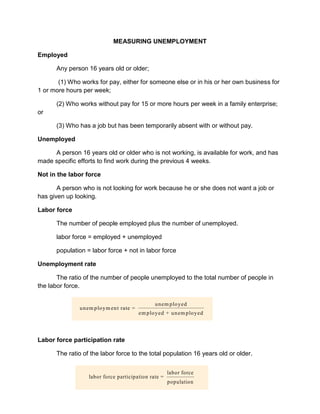
Measuring unemployment
- 1. MEASURING UNEMPLOYMENT Employed Any person 16 years old or older; (1) Who works for pay, either for someone else or in his or her own business for 1 or more hours per week; (2) Who works without pay for 15 or more hours per week in a family enterprise; or (3) Who has a job but has been temporarily absent with or without pay. Unemployed A person 16 years old or older who is not working, is available for work, and has made specific efforts to find work during the previous 4 weeks. Not in the labor force A person who is not looking for work because he or she does not want a job or has given up looking. Labor force The number of people employed plus the number of unemployed. labor force = employed + unemployed population = labor force + not in labor force Unemployment rate The ratio of the number of people unemployed to the total number of people in the labor force. unem ployed unem ploym ent rate = em ployed + unem ployed Labor force participation rate The ratio of the labor force to the total population 16 years old or older. labor force labor force participation rate = population
- 2. THE COSTS OF UNEMPLOYMENT When we consider the various costs of unemployment, it is useful to categorize unemployment into three types: 1. Frictional unemployment The portion of unemployment that is due to the normal working of the labor market; used to denote short-run job/skill matching problems. 2. Structural unemployment The portion of unemployment that is due to changes in the structure of the economy that result in a significant loss of jobs in certain industries. 3. Natural rate of unemployment The unemployment that occurs as a normal part of the functioning of the economy.Sometimes taken as the sum of frictional unemployment and structural unemployment. 4. Cyclical unemployment The increase in unemployment that occurs during recessions and depressions. Inflation is an increase in the overall price level. Sustained inflation occurs when the overall price level continues to rise over some fairly long period of time.Sustained inflation is essentially a monetary phenomenon. For the price level to continue to rise period after period, it must be accommodated by an expanded money supply. Causes of Inflation • Demand-pull inflation is inflation initiated by an increase in aggregate demand.
- 3. • Cost-push, or supply-side, inflation is inflation caused by an increase in costs. Cost-push inflation is one possible cause of stagflation—a situation in which output is falling at the same time that prices are rising. TYPES OF INFLATION Hyperinflationis a period of very rapid increases in the price level. • An increase in G with the money supply constant shifts the AD curve from AD to AD . This 0 1 leads to an increase in the interest rate and crowding out of planned investment. Deflation is a fall in the price level of the economy. It means there will be a negative inflation rate. The Consumer Price Index (CPI) A price index computed each month by the Bureau of Labor Statistics using a bundle that is meant to represent the “market basket” purchased monthly by the typical urban consumer. Producer Price Indexes (PPIs) Measures of prices that producers receive for products at all stages in the production process. The indexes are calculated separately for various stages in the production process. The three main categories are finished goods, intermediate materials, and crude materials, although there are subcategories within each of these categories.
- 4. Real Interest Rate The difference between the interest rate on a loan and the inflation rate. The indexes are calculated separately for various stages in the production process. The three main categories are finished goods, intermediate materials, and crude materials, although there are subcategories within each of these categories. Identification. Answer the following. ___________1. It is inflation initiated by an increase in aggregate demand. ___________2.Occurs when the overall price level continues to rise over some fairly long period of time. ___________3. The number of people employed plus the number of unemployed. ___________4.Measures of prices that producers receive for products at all stages in the production process. ___________5. It is a fall in the price level of the economy. It means there will be a negative inflation rate. ___________6.The increase in unemployment that occurs during recessions and depressions. ___________7.The unemployment that occurs as a normal part of the functioning of the economy. ___________8. The portion of unemployment that is due to changes in the structure of the economy that result in a significant loss of jobs in certain industries. ___________9.The portion of unemployment that is due to the normal working of the labor market; used to denote short-run job/skill matching problems. ___________10.The difference between the interest rate on a loan and the inflation rate.
